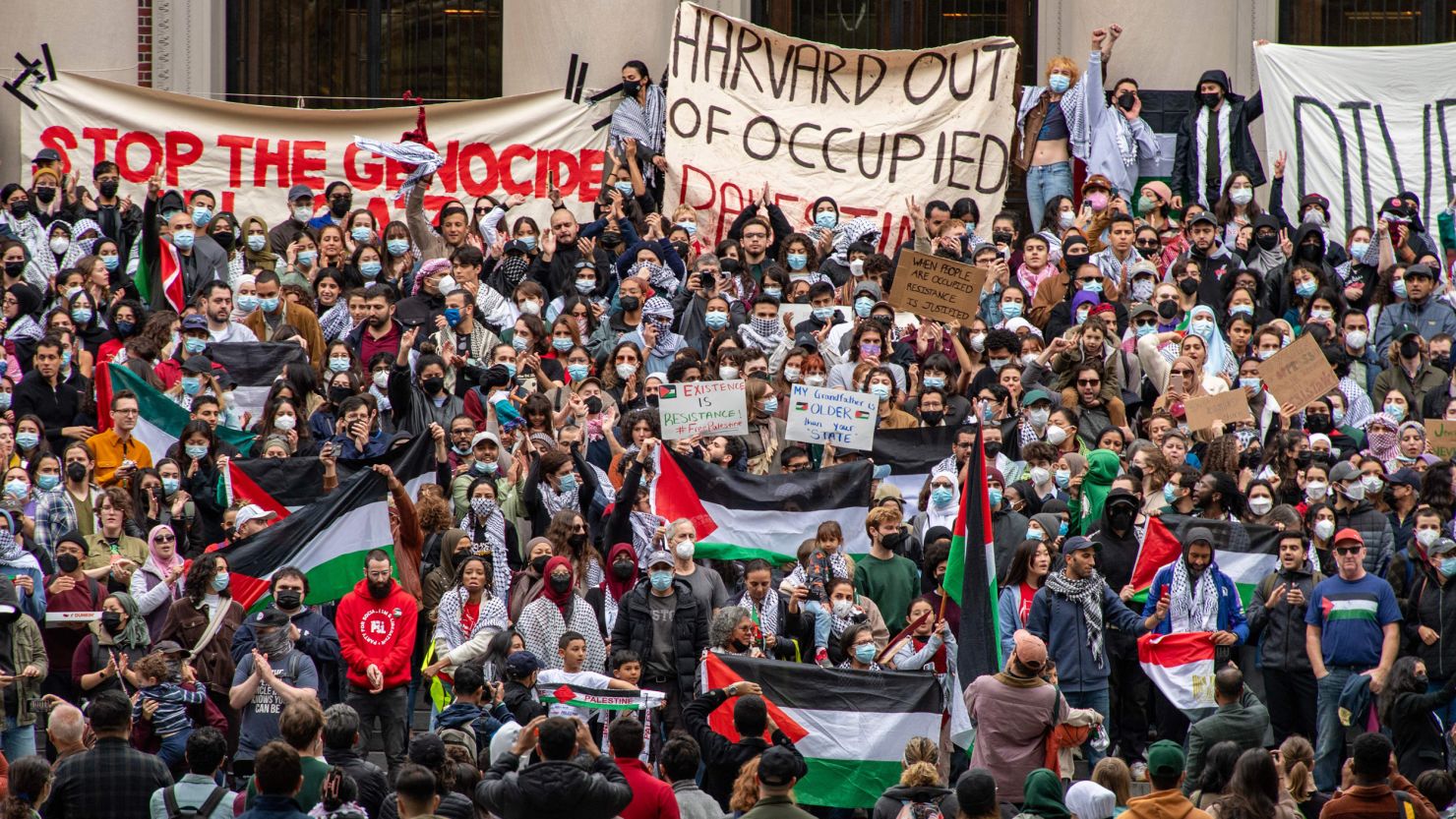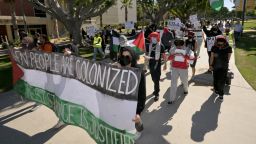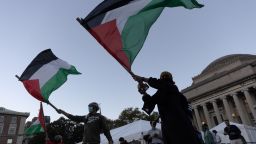Editor’s Note: Suzanne Nossel is CEO of PEN America. The views expressed here are hers. Read more opinion on CNN.
College campuses are in crisis.
As universities churn over the war between Hamas and Israel, many college presidents seem flummoxed or paralyzed. Leaders at Harvard, Rutgers, Penn, Duke, Stanford and elsewhere have issued multiple statements on the conflict, seeking to appease stakeholders irate that their first efforts either failed to forthrightly decry the Hamas attack, or neglected Palestinian suffering.

University leaders are being excoriated for what they say or don’t say, buffeted by students, faculty, alumni and donors. The uproar has led to rescinded contributions, faculty resignations and students looking to transfer. The fate of our higher education institutions will depend upon whether university leaders can fulfill their duty to simultaneously uphold free expression, curb violence and intimidation and provide equal educational opportunities for all.
The dilemma comes down to how campuses can be open to all people – meaning Jews, Muslims, Israelis, Palestinians and all other groups – and all ideas: belief in a Jewish state; favoring a single bi-national state in place of today’s Israel; the contention that Hamas’ attacks were genocidal; and the claim that the attack is best understood as an outcome of years of occupation. These dualities are hard to sustain.
For a student demonstrator, chanting “from the river to the sea, Palestine will be free” may feel invigorating; for a listener the slogan may invoke the Nazi’s annihilationist vision of “Judenrein,” a land voided of Jews. In some cases, the feelings of intimidation stoked by speech may not be unintentional; protests aim to muster a boisterous show of strength to subdue other points of view.
Some campuses have embraced the goal of “psychological safety.” Yet what makes some feel safe – say a solidarity rally protesting Israel’s incursions into Gaza – can cross over into making others feel intimidated or “unsafe” – when the rally cheers the elimination of Israel and extirpation of its people. The doxxing of students who blamed Israel for Hamas’ attacks, which some defend as simply a matter of holding speakers accountable, also amounts to a form of deliberate intimidation, that can have lasting, even career-ending consequences. The line between hateful speech and the legitimate expression of controversial sentiments often can depend upon who is doing the drawing.
These quandaries are neither new nor unique to the Israeli-Palestinian conflict. When “Make America Great Again” slogans like “Build a Wall” and “Vote Trump” were written in chalk at Emory University in 2016, some cited the messages as a mark of a racially oppressive campus climate in urgent need of overhaul while others called for students to grow thicker skin. When right-wing Milo Yiannopoulos sought to speak at the University of California at Berkeley in 2017, violent protests and counterprotests centered on whether his anti-LGBTQ and xenophobic screeds should be allowed on campus, and led to the cancellation of the event just hours before his speech.
Debates over the bounds of free speech on campus are not just a matter of overly fragile students nor a hypocritical refusal to hear out opposing viewpoints. As campuses work to eradicate the stubborn vestiges of exclusion and prejudice on the basis of race, gender, religion and other facets of identity, they have been forced to confront the ways in which expression can foster or impair particular groups of students’ sense of belonging on campus.
That drive has brought changes to curricula, drawn attention to preferred pronouns and prompted trainings to ensure students are respectful of differences in beliefs, upbringing and outlook.
For many students, college is the first time they encounter people with backgrounds and worldviews drastically different from their own. It is not enough to assemble diverse student bodies in a lecture hall or dining room and just assume that fruitful discourse across difference will magically take hold. University faculty and administrators must both model and take deliberate steps to instill constructive habits of interaction across social and ideological chasms.
When universities evolve so that students — whether they hail from the Bronx, Beverly Hills, Beersheva or Beirut — feel equally positioned to voice their opinions in the classroom, start clubs or invite speakers to campus, the result is a boon to free speech. The marketplace of ideas suffers when some voices are muted or excluded. Yet, efforts to bring about a more equitable, inclusive campus have too often hardened into enforced orthodoxies whereby speech on contested topics is shut down and stigmatized such that students and faculty begin to censor themselves for fear of reprisals.
Amid the latest round of controversies, a few guiding principles are paramount. The 14th Amendment to the US Constitution and anti-discrimination laws guarantee “equal protection” under the law, including in education. When members of a particular group — Muslims or Jews — are attacked, the university must respond with vigor and force commensurate to that afforded other groups – Black or LGBTQ students, for example — that have been or may be similarly targeted on campus. Efforts to root out discrimination on campus through investigations, education and student support must apply equally to all forms of bigotry manifest in the classroom or quadrangle.
To the extent campus harassment or discrimination policies exclude certain groups or protected characteristics, they must be swiftly amended. History, context and an appreciation of power relationships can help us grasp the import and ramifications of speech. But they cannot be an excuse to soft-pedal the response to invective. A useful thought exercise is to explore if the speech in question targeted a different racial or religious group – Jews instead of Muslims, or vice-versa – whether the proposed response would still fit.
Both the First Amendment and a principled commitment to free speech and academic freedom constrain the power of university authorities to punish even hateful speech. But neither law nor principle commends silence or neutrality in the face of bigotry. Academic leaders, while defending free speech, must be unequivocal in rejecting denigrating speech as inimical to open discourse. The very value of free-ranging debate – the notion that the answer to noxious speech is more speech – requires that stereotypes or vilifications be debunked, rebutted and denounced, including by figures of authority.
Sometimes leaders find it simplest to avoid the fray. But when students are deeply offended, campus leaders can’t simply throw up their hands citing “free speech!” Rather, by showing empathy, forcefully articulating the university’s own values, mobilizing campus leaders to voice support, offering counseling and publicly demonstrating solidarity, leaders can make plain that protecting speech does not mean condoning it. Sitting down for a meal with affected students, taking part in a vigil or visiting a student center can be powerful ways for leaders to convey what they do and don’t stand for.
One lesson that the “all lives matter” debate amid the Black Lives Matter movement taught us is that when members of one group are enduring acute pain that they believe has been overlooked, the answer is not to broaden the discussion to encompass everyone else’s trauma. In initial statements issued just after Hamas’ October 7 attack, Harvard, Stanford and other universities were faulted for failing to lay blame for the murderous assault, or name the targets as Jewish Israelis. Leaders should resist the impulse to lump distinct hardships together. A high-profile incident of antisemitism, racism or Islamophobia is not the moment to blandly denounce all bigotries. Leaders need to make sure their empathy toward individual constituencies is not just voiced, but heard.
Even hateful and vitriolic words must not be equated with physical violence, lest they become excuses for violent reprisals. But sometimes, of course, speech breaches the bounds of First Amendment protection – because it directly threatens, incites imminent violence, harasses individuals, damages property or otherwise. When speeches crosses over into intimidation, threats and harassment, administrators must recognize the difference, meeting criminal or unpermitted activity with not just words but decisive action.
Get Our Free Weekly Newsletter
- Sign up for CNN Opinion’s newsletter
- Join us on Twitter and Facebook
There is no hope of a campus being a safe space for broad-ranging ideas if students feel physically endangered; enhanced security can both deter misdeeds and signify the university’s will and capacity to protect. By demonstrating publicly that those responsible for hate-fueled actions will be held strictly accountable the university can defend the essential norms that underpin a healthy learning environment.
To sustain free speech in a diverse society requires that each of us exercise conscientiousness with language, grasping how words are understood, including by those with backgrounds and allegiances unlike our own.
The chanter of a slogan must not just know how their words will sound to others, but also to care. That obligation of conscientiousness toward fellow students and citizens cannot be enforced by authorities. But it can be nurtured by universities that define their mission as teaching not just academic subjects, but also the disciplines required to live peaceably in a pluralistic society.






